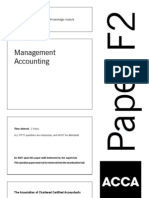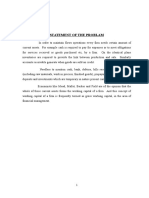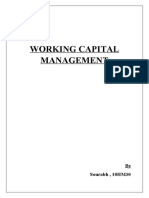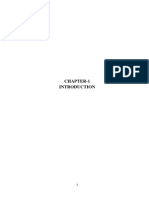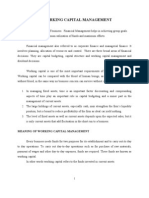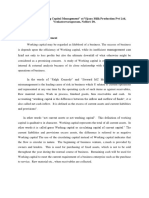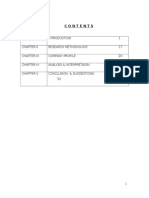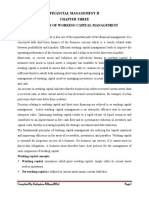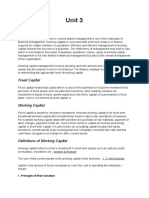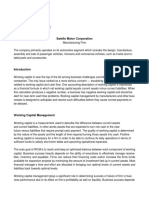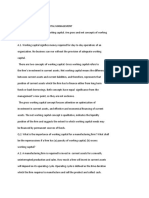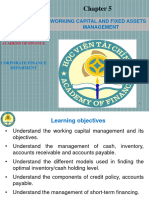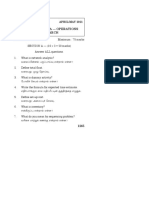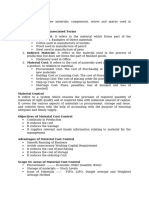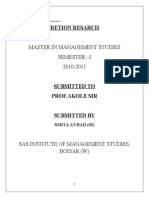Chapter Two Literature Review: I. Gross Concept II. Net Concept
Chapter Two Literature Review: I. Gross Concept II. Net Concept
Uploaded by
Sachchithananthan ArikaranCopyright:
Available Formats
Chapter Two Literature Review: I. Gross Concept II. Net Concept
Chapter Two Literature Review: I. Gross Concept II. Net Concept
Uploaded by
Sachchithananthan ArikaranOriginal Title
Copyright
Available Formats
Share this document
Did you find this document useful?
Is this content inappropriate?
Copyright:
Available Formats
Chapter Two Literature Review: I. Gross Concept II. Net Concept
Chapter Two Literature Review: I. Gross Concept II. Net Concept
Uploaded by
Sachchithananthan ArikaranCopyright:
Available Formats
CHAPTER TWO Literature Review
2.0 Introduction
This chapter mainly involves two parts one is theoretical back round of working capital management and empirical evidences. Working capital management refers to all management decision and actions that ordinary influence the size and effectiveness of the working capital. It is concerned with most effective choice of working capital source and the determination of the appropriate levels of the current assets and their use. It focuses attention to the managing of the current assets, current liability, and their relationship that exists between them. In other words, working capital management may be defined as the management of a firms liquid assets.
2.1 Theoretical Back round
Working capital is current assets minus current liabilities; working capital may also be viewed as the amount of a business current assets provided (financed) by long term debt and equity. Working capital management is one of the important aspects of overall financial management. Every firm must maintain adequate level of working capital. Current assets should be greater than the current liabilities in order to ensure a reasonable safety. Proper management of working capital is very important for success of an enterprise. It aims at protecting the purchasing power of assets and maximizing the return of investment. There are two concepts if working capital. I. Gross concept II. Net concept
The Gross concept refers to firms investment in current assets. This can be converted in to cash within an accounting year and include cash, short term liabilities, debtors, bill receivable and stock. The net working capital means to the different between current assets and current liabilities. Current liabilities are account payable, creditors, bank overdrafts and outstanding expenses (By:-hawrance). Net working capital may be positive or negative. Kennedy and Macmullan say that the excess of current assets over current liabilities is the net working capital which represents the amount of current assets it would remain if all the current liabilities were paid. The key issue in working capital management is to avoid running out of cash and understanding how to manage cash effectively requires knowledge of working capital. The importance of efficient working capital management is indisputable. Business viability relies on its ability to effectively manage receivables, inventory and payables. By minimizing the amount of funds tied up in current assets, firms are able to reduce financing costs and or increase the funds available for expansion. Much managerial effort is put into bringing non optimal levels of current assets and liabilities back towards their optimal. While the performance levels of small business have traditionally been attributed to general managerial factors such as manufacturing, marketing and operations, working capital management may have a consequent impact on small business survival and growth (Kargar and Blumenthal 1994). The management of working capital is important to the financial health of business of all size. The amount invested in working capital is often high in proportion to the total assets employed and so it is vital that these amounts are used in an efficient and effective way. However there is evidence that small business are not very good at managing their working capital. With regard to the factors influencing working capital requirement are of different importance. Also the importance of factors changes for a firm over time. There fore an analysis of relevant factors should be made in order to determine total investment in working capital. Working capital requirements of a firm basically related to the type of
business contacts when comprising manufacturing and service industry firm working capital requirements and components of capital will differ. Most firms experience seasonal and cyclical fluctuations in demand for their product and services. These business variations affect the working capital of firms. There is an upward rising in the economy, sakes wick increases correspondingly. Working capital need of the firm increases as it grows in terms of sales or fixed assets. It is certainty difficult to assume relationship between volume of sales and requirements of working capital. The strategy of constant production may be maintained in order to resolve the working capital problem arising due to seasonal changes in the demand for the firms product. 2.1.1 Working capital management and risk return tradeoff
A firm can increases net working capital by to its current assets relative to its liabilities (for example holding larger level of inventories marketable securities) or by decreasing its current liabilities relative to current assets (for example by using long term sources of finance such as bonds rather than banks lone must be repaid within the year) Consider first the effect of increasing firms net working capital by holding lager investments in marketable securities and inventories with out changing the firms used of current liabilities other things remaining the same this has the effect of increasing the firms liquidity. That is with the additional marketable securities the firms has a ready source of funds need to at experience an unexpected shortfall in this cash flow. In addition the added inventories reduce the chance of production stoppages and the loss of sales from inventory shortage. However these additional current assets investment earn very low return. Now consider the effect of reducing a firms net working capital by substituting short term financing such as payables that must be repaid in one year or less for long for long term sources such as bonds. The use of short term financing increases the firms profitability for two reasons. First short term financing usually carries a lower rate of
interest than less long term financing. In addition when short term source of financing are used to finance a firms seasonal needs for financing (such as the build up of inventories for are tail firm period to the Christmas season) the firm can repay the funds after the sectional need has expired. Thus requiring the firm to pay invests only during the period when the funds are needed. If long term financing are used, the firm will end of holding excess cash during these time of the year. When sectional financing needs are zero, thus incurring additional borrowing costs are reducing over all profitability. Short term financing increased a firm risk of not being able to pay is bill on times or the risk of liquidity. This corresponds to the commonsense nation that short financing must be repaid more frequently than long term financing, thus exposing the firm to additional risk of having the financing come due at the time when its financial condition might make it difficult to repay the loan. Working capital decision provides a classic example of the risk return trade off of financial decision making. Increasing the firms net working capital reduces the risk that the firm will not be able to pay its bills in time (risk if illiquidity) but at the same time, reduces the overall profitability of the firm. Operating cycle or working capital cycle The duration of time required to complete the following cycle of events on case of a manufacturing firms is called the operating cycle. 01. Conversion of cash into raw material. 02. Conversion of raw material into working process. 03. Conversion of work in process in to finished goods. 04. Conversion of finished good in to debtors and will receivables bought sales. 05. Conversion of debtors in to cash.
10
The basic objective of working capital management is to manage the firms current assets and liabilities in such a way that a satisfactory level of working capital is mentioned i.e. it is neither in adequate nor excessive. In order to achieve this objective the finance manager has to perform basically following two functions I. Estimating the amount of working capital. II. Shows from which these funds have to be raised. 2.1.2 Determinates of working capital There are so many factors influencing the working capital management of the firm. Every factor is important in different ways. And also the important of factors changes for a firm over time. Therefore and analysis of relevant factors should be made in order to determine total investment on working capital. The factors that determine the amount of working capital of the firm are as follows Nature and size of business Working capital requirement of a firm are basically influenced by the nature of its business. Trading and financial firms have small investments in fixed assets than other manufacturing firms, but require a large sum of money to be invested in working capital. The size of the business also has an important impact on its working capital needs. Size may be measured in terms of the scale of the operation. A firm with lager scale of operation will need more working capital than a small firm. Manufacturing cycle Manufacturing cycle comprises of the purchase and use of raw materials and the production of finished goods, Longer the manufacturing cycle, large will be the firms working capital requirements.
11
Sales growth The working capital needs of the firm increases as it grow. It is difficult to precisely determine the relationship between volume of sales and working capital needs in practices. Current assets will have to be employed before growth take place it is there for necessary to make advance planning of working capital for growing firms on a continuous basis. Demand condition Most firms experiences seasonal and cyclical fluctuations in the demand for their products and services. These business variations affect the working capital requirements specially the temporary working capital requirements of the firm. When there is an upward swing in the economy, sales will increase correspondingly the firms investments in inventories and book debts will also increase. Production policy A steady production policy will cause inventories to accumulate during the off season periods and the firm will be exposed to greater inventory cost and risks. Thus its costs and risk of manufacturing a constant production schedule are high, the firm may adopt the policy of varying its production schedules in accordance with changing demand. Pricing level changes The increasing shift in price level make functions of financial manager difficult. He should anticipate the effect of price level changes on working capital requirements of the firm. Generally rising price level will require a firm to maintain higher amount of working capital. Same level of current assets will need increased investment when prices are increasing. However companies which can immediately revise their product prices with rising price levels will not face a severe working capital problem.
12
Operating efficiency and performance Operating efficiency of the firm related to the optimum utilization of resources at minimum costs. The firm will be effectively contributing to its working capital if it is efficient in controlling operation costs. Better utilization of resources improves profitability and, thus helps increasing the pressure on working capital. Although if may not be possible for firm to control prices of material or wages of labors, it can certainty ensure efficient and effective use of its materials, labors and other resources. Firms credit policy The credit policy of the firm affects working capital by influencing the level of debt. The credit terms to be granted to customers may depend up on norms of the industry to which the firm belongs, but a firm has the flexibility of shaving its credit policy within this constrains of industry norms and practices. Availability of credit The working capital requirement of a firm also will be affected by credit terms granted by its creditors. A firm will need less working capital if liberal credit terms are available to it. Similarly the availability of credit from bank also influences the working capital needs of the firm. A firm which can get bank credit easily will operate with less working capital than a firm with out such of a facility. 2.1.3 Kinds of Working Capital The working capital amount of a firm can be classified into two types based on duration. 1. Permanent working capital 2. Temporary working capital 11. Permanent working capital: This component represents the value of the current assets required on a continuing basis over the entire year, and for several years. Permanent working capital is the minimum amount of current assets, which is needed to conduct a business even during 13
the dullest season of the year. The minimum level of current assets is called permanent or fixed working capital as this part is permanently blocked in current assets. This amount varies from year to year, depending upon the growth of the company and the stage of the business cycle in which it operates. It is the amount of funds required to produce the goods and services, which are necessary to satisfy demand at a particular point of time. It represents the current assets, which are required on a continuing basis over the entire year. It is maintained as the medium as to continue the operations at any time. Characteristics of Permanent working capital 1 It is classified on the basis of the time period 2 It constantly changes from one asset to another and continues to remain in the business process. 3 Its size increase with the growth of business operations. 12. Temporary working capital: Contrary to the above you will find that temporary working capital represents a certain amount of fluctuations in the total current assets during a short period. These fluctuations are increased or decreased and are generally cyclical in nature. Additional current assets are required at different times during the operating year. Variable working capital is the amount of additional current asset that are required to meet the seasonal needs of a firm, so is also called as the seasonal working capital. For example: additional inventory will be required for meeting the demand during the period of high sales When the peak period is over variable working capital starts decreasing or very little during the normal period. It is temporarily invested in current assets. Say for an example a shopkeeper invests more money during winter season because he/ she require keeping more amount of stock of woolen cloths. The same happens in a sugar factory how: the factory manager buys more quantity of sugarcane during the harvesting season and them continuously stops for some time.
14
Characteristics of Temporary working capital 1 It is not always gainfully employed, though it may change from one asset to another asset, as permanent working capital does. 2 It is particularly suited to business of a seasonal or cyclical nature. 2.1.4 Sources of working capital Financing of additional working capital requirements in an environment becomes a real problem to a finance manager of concerned units. Commercial banks play the most significant role in providing working capital finance particularly in the Indian context. In view of mounting inflation, the reserve bank of India has taken up certain fiscal measures to check the money supply in the economy. The balancing need has to be managed either by long term borrowings or by issuing equity earning sufficient profits and retaining same for coping with the additional working capital requirements. The first choice of before finance manager, where part of additional working capital is not provided by banks is to take the long term source of finance. 1. Long term financing Loans from financial institutions. Floating of debenture Accepting of public deposit Issue of share Raising funds by internal financing.
2. Short term financing Short term financing refers to those sources of short term credit that the firm must arrange in advances. This source includes short term banks loans commercial paper & factoring receivables.
15
3. Spontaneous financing Spontaneous financing refers to the automatic sources of short term funds. The major sources of such financing are wade credit (creditors & bill payable) out standing expenses. Spontaneous source of finance are cost free. There fore a firm would like to finance its current assets from Spontaneous source as much possible. In the present day context of rising capital cost and scare funds, the importance of working capital needs special emphasis. It has been widely accepted that the profitability of a business concern likely depends upon the manner in which its working capital is managed, the inefficient management of working capital not only reduces profitability but ultimately may also led a concern to financial crisis. On the other hand proper management of working capital leads to a material savings and ensure financial returns at the optimum level even on the minimum level of capital employed. We also know that both excessive and in adequate working capital is harmful for a firm. 2.1.5 Cash Management Cash is the most important current assets for the operations of the business. Cash is the basic input needed to keep business running on a continuous basis. It is also the ultimate output expected to be realized by selling the service, product manufactured by the firm should keep sufficient cash neither move nor less cash shortages will disrupt the firms manufacturing operations while excessive cash will simply remade idle, without contributing anything towards the firms profitability. Thus a major function of financial manager is to remain a sound cash position. Cash is the money which the firm can disburse immediately with out any restriction. The term cash include coins, currency, cheques held by the firm and balance in its bank account. Cash management is concerned with managing of cash flow into and out of the firms. Cash management assumes more important then other current assets, because cash is the more significant and least productive assets that a firm holds. It is significant because it is used to pay the firms obligation however cash is the
16
unproductive unlike fixed assets or inventory it doesnt produce goods for sale therefore a aim of cash management is to used cash is some profitable way. The management of cash is also important because it is difficult predict cash flows accurately particularly the inflow and that there is no perfect coincidence between then inflow and out flows of cash. Cash constitutes the small portion in current assets. An obvious aim of cash management is to manage its cash affairs in such a way to keep cash balance at a minimum level and to invest the surplus cash funds in profitable opportunities. The firm should evolve strategies regarding a following four facets of cash management such a cash planning and managing the cash flow, optimum cash level and investing surplus cash (by I.M.Pendey) cash budget is the most significant device to plan and control cash receipts and payments a cash budget is summery statement of the firms expected cash flow in a projected time period Cash vs Profit The distinc5tion between profit and cash is often not understood clearly. Cash flow is believed to be akin to profit before depreciation and other non cash expenditure. The difficulty is that the income statement doesnt contain working capital items like receivable and inventories which capture a sizable part the revenue giving less or amount of cash to the system. Enterprise managers often complain that in spite of their companies making good profit they continue to remain in had to mouth condition in discharging their day today obligations. There is nothing wrong in making profit, in fact that is the purpose of businesses, but unless there is cash coming through profit, an enterprise will soon be dead cash is an lifeline of organizations. A sustained growth of an enterprise depend upon the cash ability of the profit, not the profit per as reflected in the income statement. Although in the long run all working assets (and for that matter all assets) are cashable (and perhaps, this is the
17
reason why all profit flow in the long term profit appraisal are termed as cash flow), a cash shortage in the short run may not allow a company to see out a long term at all. Cash flow and cash stock There is the distinction between cash and cash stock, which may be understood clearly, cash is an assets and like any other assets, it earn only when it is in used in other words when cash is in the flow it is earning for the enterprise, when it is idle, not only that it doesnt earn, it also contribute negatively to the profitability of the enterprise, because the funds that is tied to idle cash has to be carried at a cost. The situation is similar to that of a machine which has been bought but kept idle. An enterprise must, therefore make its cash work as hard as possible. Motives for holding cash 11. The transaction motive: Firms are in existence to create products or provide services. The providing of services and creating of products result in the need for cash inflows and outflows. Firms hold cash in order to satisfy the cash inflow and cash outflow needs that they have. 12. The precautionary motive: Holding cash as a precaution serves as an emergency fund for a firm. If expected cash inflows are not received as expected cash held on a precautionary basis could be used to satisfy short-term obligations that the cash inflow may have been bench marked for. 13. Compensating motive: Banks provide a variety of services to business firms, such as clearance of cheque, supply of creditetc., for which a minimum balance is required to be kept with the bank; this balance is to compensate banks for services rendered.
18
14. The speculative motive: Economist Keynes described this reason for holding cash as creating the ability for a firm to take advantage of special opportunities that if acted upon quickly will favor the firm. An example of this would be purchasing extra inventory at a discount that is greater than the carrying costs of holding the inventory. Cash management is concerned with the managing of: 11. Cash flows into & out of the firm, 22. Cash flows within the firm 33. Cash balances held by the firm at a point of time by financing deficit or investing surplus cash.
19
2.1.6
Receivables management All firms by their very nature are involved in selling either goods or services. Although some of these sales will be for cash, a large portion will involve credit whenever a sale is made on credit it increases the firms account receivables. When a firm sells goods and service, it can demand cash on or before the delivery date or it can extend credit to customers and allow some delay in payment. Granting credit is making an investment in a customer, an investment tied to the sale of a product or service. Thus the importance of how a firm manages its accounts receivable depends on the degree to which the firm sells on credit. A firm grants trade credit to maintain its sales from the competitors and at the same tine to attract the potential customers to purchase its product at favorable term. Trade credit arises only when the firm sells its product to customer but doesnt receive immediate cash. Receivable management considers the impact of credit decision on working capital and particularly on cash flow. The most important factor in the managing cash in a small firm is the ability to collect account receivable quickly. A firms cash account is directly affected by granting credit sales to customers. Why do firm grant credit? Not all do but the practices are extremely common. The obvious reason is that offering credit is away of stimulating sales. The cost associated with granting credit is not trivial; first there is chance that the customer will not pay. Second, the firm has to bear the cost of carrying the receivables. The credit policy decision thus involves a trade off between the benefits of increased sakes and the cost of granting credit.
Slow payments erode profits and can lead to bad debts
Slow payments has crippling effect on business in particular on small business who can least effort it If you dont manage debtors they will begin to manage your businesses as you gradually lose control due to reduced cash flow and of course, you could experience an increased incidence of bad debts.
The cash flows from granting credit.
Credit sales is made
Customer mails check
Firm deposits check in banks
Bank credits firms account
Cash collection Account receivables
The Investment in Receivables The size of investments in accounts receivable is determined by several factors. First the percentage of credit sales to total assets affects the level of accounts receivable held. Although this factor certainty plays a major rile in determining a firms investment in account receivables, it generally is not within the control of the financial manager. The nature of business tends to determine the blend between credit sales and cash sales. The level of sales is also a factor in determining the size of the investment in accounts receivable. As the firm experiences seasonal and permanent growth in sakes, the level of investment on receivables will naturally increase. Thus although the level of sales affects the size of investment on accounts receivable, it is not a decision variable for the financial manager.
The final determinants of the receivables are the credit and collection periods more specially the terms of sales, the type of customer and collection efforts. The terms of sale specify the both the time period during which the customer must pay and the terms such as penalties for late payments and discount for early payments, the type of customer or credit policy also affects the level of investments in accounts receivable collection and credit policy decision may further affect the level of investment in accounts receivable by causing changes in the sales level and the ratio of credit sales to total assets. The total credit cost curve The trade off between granting credit and not granting credit is not hard to identify, but it is difficult to quantity precisely. Credit cost curve is a graphical representation of the sum of the camping costs and the opportunity cost of a credit policy. Figure 2.1.1 Total credit cost curve
Total costs Optimal amount Carrying costs Carrying cost are the cash flows that must be incurred when credit is granted. They are of credit positively related to the amount of credit extended. Opportunity costs are the lost sales Costs resulting from refusing credit. These costs go down when credit is granted. Opportunity Costs Amount of credit extended
2.1.7
Inventory Management
Inventory refers to the physical stock of goods kept for the future production or sales. It is essential for the smooth running of the organization or firm. Inventory includes raw material, component, subassemblies and finished goods. For a long time inventory management remained every bodys concern but nobodys responsibility. Every organizational unit along the productive distributive channel of an enterprise want to have full control over the inventory, it deals in the purchasing department material inventory, production department for work in process and marketing department for finished goods inventory. World wide the corporate failures during after the second world war and lately during 70s led the corporate thinkers to redefine the goal of inventory management as a part of overall material management of enterprise. Material requirement planning (MRP) which emerged as a new discipline attempted to define inventory management as an integral part of MRP whose broad goals areTo minimize investment in inventory. To ensure smooth and efficient operation of plant. To maximize customer service and satisfaction.
Inventory management techniques The goal of inventory management is usually framed as cost minimization Three techniques are in inventory management. i. ii. iii. ABC analysis. Economic order quantity model. Managing derived Demand inventoried.
ABC approach The ABC approach is a simple approach to inventory management in which the basic idea is to divide inventory into more groups. The underlying rationale is that a small portion of inventory in terms of quantity might represent a large portion in terms of inventory value. For example this situation would exist for a manufactures that uses some relatively expensive, high tech components and some relatively in expensive basic material in producing its products. Below figure illustrates an (abc) comparison of item in terms of the percentage of inventory value represented by each group versus the percentage of item represented. In figure group A constitutes only 10% of inventory by item count, but of represents over half of the value of inventory. 403020100102030405010% 28% 45%
A
35%
B
17%
C
12%
Figure 2.1.2 ABC analysis model
Economic order Quantity model EOQ model is the vest known approach for explicitly establishing an optimal inventory level. The basic idea is illustrated in below figure, which pilots the various casts associated with holding inventory (on the vertical axis) against inventory level (on the horizontal axis). Total cost of holding inventory
Ordering Cost
Cost of holding Inventory
Optimal size of inventory order Figure 2.1.3 EOQ Model Carrying costs
Its assumed that a company will let its inventory rundown to zero and then reorder, in reality a company will wish to reorder before its inventory goes to zero for two reasons. First by always having at least some inventory on hand, the firm minimizes the risk of a stock out and the resulting loess of sales and customer, second when a firm does reorder, there will be some time lag before the inventory arrives. A safely stock is the minimum level of inventory that firm keeps on level. Inventories are reordered whenever the level of inventory falls to the safely stock level. Reorder points to allow for delivery time a firm will place orders before inventories reach the critic level. The reorder points are the times at which the firm will
actually place is inventory orders. One of the reasons that a firm will keep safely stock is to allow for uncertain delivery times.
Managing derived demand inventories The three type of inventory management technique is used to manage derived demand inventories. Material requirement planning and just in time inventory management are two methods for managing demand dependent inventories. The basic ides behind the MKP is that once finished goods inventory level are set, it is possible to determine what level of work in process inventories must exist to meet the need for finished goods. From there, it is possible calculate the quality of raw materials that must on hand, this ability to schedule backwards from finished goods inventory stemp from the dependent nature working process and raw material inventories ,MKP is particularly important for complicated products for which a variety of components are needed to create the finished product. Just in time (JIT) inventory is a modern approach to managing dependent inventories. The goal of just in time is to minimize such inventories, there by minimizing turnover. The approach began in Japan, and it is a fundamental part of Japanese manufacturing philosophy. As the name suggest, the basic goal of JIT is to have only enough inventory on hand to meet immediate producing needs.
2.2 Empirical Evidences
A study conducted in the name of relationship between working capital management and profitability of listed companies in the Athens stock exchange. They used to sample of 131 companies listed in Athens stock exchange for the period of 20012004. The purpose of this paper is to establish a relationship that is statistically significant between profitability the case conversion cycle and it is components for the listed firm in the ASE. The result of their research showed that there is statistical significance between profitability measured through gross operating profit and the case conversion cycle. A study curried by capto that discusses how focus on working capital management increases share holders value through and instant increase in cash flow, lowered future level of working capital and increased margin through improved routines and processes. CAPTO complied level of working capital margin and marked value for some so of Swedens largest industrial. They discussed the connection between a relatively low level of working capital higher company value. Accounting the figure as could be expected earlier studies performed by capto have shown same connection indicating that the Patten is stable over business cycles. A questioner Study was conducted by Paul.E.nix, and Mwlvin L.Mcfeteridge to find out the Montana business managers use of the working capital concept. Perceptions of the business manager regarding the flowing questions were employed. Henders willingness to finance current asset requirements on both a short term and a long term basis. The present financing of current assets. The majority of business firms in this study found it difficult to obtain long term credit financing for even a portion of current assets, and are apparently unaware of the working capital concept.
Anup chowdhury and Md. Muntasir Amin (2007) conducted a research working capital management practiced in pharmaceutical companies listed in share stock exchange. The objective of this study is to be critically evaluating working capital management as practiced in the selected firms of the pharmaceutical industry. To achieve this goal the study also examined the policy and practices of cash management; evaluate the principles, procedures and techniques of inventory management, receivable management and payable management. A positive correlation had been found in the mathematical model, between current assets management and financial performance of pharmaceutical firms. A survey done by Greg filbeck and Thomas Krueger (2002 ) that an analysis of working capital management results across Industries. They provide insight into the performance of surveyed firms across key components of working capital management. They discovered that significant differences exist between industries in working capital measures, themselves, change significantly within industries across time. Rebert kischnick mark, La plante and Robin Moussawi (2006)examined the implication of a corporations working capital management for its valuation, consistent with industry surveys, we find evidence that firms over invest in working capital. Given this evidence, we then focus on what factors influence corporate working capital management. They found that industry practices, firm size, future firm sakes growth, the proportion of outsider directors on a broad, executive compensation and CEO share ownership significantly influence the efficiency of a companys working capital management. Overall their evidence suggests that managers respond positively to incentives and monitoring in managing their firms working capital. A study conducted by Kessevan Padachi(2006) is the trend in working capital management and its impact on firms performance. The trend in working capital needs and profitability of firms are examined to identify the causes for any significant differences between industries the different variable, return on total assets was used as a measure of profitability and the relation between working capital management and
corporate profitability is investigated for a sample of 58 small manufacturing firms using panel data analysis for the period 1998-2003. The regression results show that high investment in inventories and receivables is associated with lower profitability. An analysis of the liquidity, profitability and operational efficiency of the five industries shows significant changes and how best practices in the paper industry have contributed to performance. The finding also reveals an increasing trend in the short term component of working capital financing. A research conducted by P.C.Narware shows that working capital and profitability of the company disclose with both positive and negative association. The slope of the ROI equation depicted that positive and negative influence of variations in the independent variables on the profitability of the company. The coefficient of multiple determination (R2) makes it obvious that 68.5 percent of the total variation in the profitability of the company. WCL of the company concluded, the increase in the profitability of the company was less than the proportion to decrease in working capital.
A cause study conducted by Abdul Kahman and Mohamed Nasir (2007) that was working capital management and profitability of Pakistan firms. Working capital management has its effect on liquidity as well on profitability. They have selected a sample of 94 firm listed on Karachi stock exchange for a period of 6 years from 19942004. They had studied the effect of different variables of working capital management on profitability of Pakistan firms. The results showed that there is a strong negative relationship between variables of working capital management and profitability of the firm. It means that as the cash conversion cycle increases it will lead to decreasing profitability of the firm. They found that there is a significant negative relationship between liquidity and profitability. They also fund that there is a positive relationship between firm size and its profitability.
T.Afza and M.S.Nasir conducted a study Is it better to be Aggressive or conservation in managing working capital? This study investigated the relationship among the aggressive /conservative working capital polices and profitability as well as risk of firms for 208 public limited companies listed at KSE fir the period of 1998-2005. The empirical results found the negative relationship between working capital policies and profitability validating the findings of carpenter and Johnson (1983) and found no significant relationship between the level of current assets and liabilities and risk of the firms. A study done by Christoper.F.Baum, Dorothea Sch afer and Oleksandr Talavera that was the effect of short term liabilities on profitability. A comparison is made between two countries, the USA and Germany with different types of financial systems. They find that German firms that rely more heavily on short term liabilities ate likely to be more profitable. The link between liability maturity structure and profitability does not appear in the results from the US sample, which reflects the importance of institutional factors. Amirshan and Sana pointed out in their study (Impact of working capital management on the profitability of oil and gas sector in Pakistan), that, there is negative relationship between working capital and profitability of the firm. They used working capital ratio such as inventory turn over, receivables ratio, payables ratio, current ratio, quick ratio and cash conversion cycle. The results show a negative relationship between gross profit margin and number of days account payables. Their analysis also suggest that manage can generate positive return for the share holders by managing the working capital. A study conducted by Don B.Bradley and Michal J.Rubach that is trade credit and small business failures? This study examined tile association between trade credit and filing fir bankruptcy by 131 small businesses. The findings suggest that there is a relationship between poor working capital management and organizational failure, a
better understanding of the causes of business failures should assist small business profect them selves and improve their credit practices are provided. Nazir and Main Sajid conducted a study that is on the factors determining working capital requirements. They had use 204 manufacturing firms from 16 industrial groups listed at Karachi stock exchange for a period of 1998-2006. The working capital requirements have been used as the dependent variable where as various financial and economic factors have been used as the determinants of working capital management. They have found that operating cycle leverage and KOA are the internal factors which are influencing the working capital requirements significantly and nature of industry also influence in the working capital requirements. In this part, the researcher has discussed mainly two part that are theoretical background and empirical evidences. Theoretical background involved theories relating to working capital management and empirical evidences involved findings of the previous researches relating to this research problem. The following chapter describes methodology of the study so we can clearly identify that what techniques used to analysis data, sampling method, hypotheses conceptual model and operationalization.
You might also like
- Understanding Financial Statements (Review and Analysis of Straub's Book)From EverandUnderstanding Financial Statements (Review and Analysis of Straub's Book)Rating: 5 out of 5 stars5/5 (5)
- GROUP 4 PRACTICE QUESTIONS ON OPM - Volume 2Document11 pagesGROUP 4 PRACTICE QUESTIONS ON OPM - Volume 2Humphrey OsaigbeNo ratings yet
- F2 - Past PapersDocument298 pagesF2 - Past Papersbilligee73% (11)
- WCM at Bevcon PVT LTD.Document65 pagesWCM at Bevcon PVT LTD.moula nawazNo ratings yet
- Principles of Working Capital Management-1Document29 pagesPrinciples of Working Capital Management-1margetNo ratings yet
- Working Capital Management: by Sourabh, 10HM30Document6 pagesWorking Capital Management: by Sourabh, 10HM30Sourabh JainNo ratings yet
- LCM MBA Summer Training Project SAIL WCDocument85 pagesLCM MBA Summer Training Project SAIL WCrohit_indiaNo ratings yet
- Working Capital ManagementDocument16 pagesWorking Capital Managementsidhantha100% (12)
- Working Capital Management in Vardhman-Final ProjectDocument84 pagesWorking Capital Management in Vardhman-Final ProjectRaj Kumar100% (3)
- Working CapitalDocument15 pagesWorking CapitalAdeem AshrafiNo ratings yet
- Working CapitalDocument9 pagesWorking CapitalSahil PasrijaNo ratings yet
- ProjectDocument62 pagesProjectvinodhknatrajanNo ratings yet
- WDCCB Working CapitalDocument53 pagesWDCCB Working Capital2562923No ratings yet
- Working Capital Project ReportDocument87 pagesWorking Capital Project ReportPranay Raju RallabandiNo ratings yet
- Working CapitalDocument7 pagesWorking CapitalSreenath SreeNo ratings yet
- WORKING CAPITAL Kesoram FinanceDocument48 pagesWORKING CAPITAL Kesoram Financerajinikanth dasiNo ratings yet
- Chapter - I: Working Capital ManagementDocument113 pagesChapter - I: Working Capital ManagementVigneshwaran BbaNo ratings yet
- Research MethodologyDocument54 pagesResearch MethodologyK SATHYANo ratings yet
- Lesson 7 Working Capital ManagementDocument30 pagesLesson 7 Working Capital ManagementDavid Lumaban GatdulaNo ratings yet
- JK Tecnology FileDocument75 pagesJK Tecnology FileAhmed JunaidNo ratings yet
- Meaning of Working Capital ManagementDocument52 pagesMeaning of Working Capital Management2562923No ratings yet
- Project On Working Capital ManagementDocument16 pagesProject On Working Capital ManagementVineeth VtNo ratings yet
- Principles of Working Capital ManagementDocument45 pagesPrinciples of Working Capital ManagementSohini ChakrabortyNo ratings yet
- KiranDocument28 pagesKiranlordmadhu23No ratings yet
- Working CapitalDocument10 pagesWorking CapitalVamsi VypuNo ratings yet
- Working CapitalDocument18 pagesWorking CapitalAbhilasha MathurNo ratings yet
- Working Capital Kesoram FinanceDocument56 pagesWorking Capital Kesoram FinanceRamana GNo ratings yet
- Working Capital Management - ChotaDocument35 pagesWorking Capital Management - Chotaavinashpandey10102001No ratings yet
- Sudhakar PVCDocument49 pagesSudhakar PVCAnusha ReddyNo ratings yet
- Project EditedDocument43 pagesProject Editedmrcopy xeroxNo ratings yet
- Anandhu-Working Capital Management at Trivantracore Cement LTD 1500 Without CertificateDocument57 pagesAnandhu-Working Capital Management at Trivantracore Cement LTD 1500 Without CertificatePRIYAM XEROXNo ratings yet
- Working Capital Management: DefinitionDocument50 pagesWorking Capital Management: DefinitionĶąřťhï ĞõűđNo ratings yet
- Business Finance IIDocument73 pagesBusiness Finance IIyakubu I saidNo ratings yet
- FM II Chapter Three Revised by KefeDocument9 pagesFM II Chapter Three Revised by KefekefeNo ratings yet
- Unit 3Document35 pagesUnit 3deepikaNo ratings yet
- 1PROJECT - REPORT On Working Capital ManagementDocument81 pages1PROJECT - REPORT On Working Capital ManagementSaaribh SinhaNo ratings yet
- Wordsatello CorporationDocument6 pagesWordsatello Corporationcyrell015No ratings yet
- Working Capital ManagementDocument62 pagesWorking Capital ManagementSuresh Dhanapal100% (1)
- Business Finance HandoutDocument22 pagesBusiness Finance HandoutEmilia JacobNo ratings yet
- Chapter 27 of FMDocument12 pagesChapter 27 of FMAsfi Abbasi100% (1)
- Management of Working Capital: Ajeet Kumar ThakurDocument125 pagesManagement of Working Capital: Ajeet Kumar ThakurDilip Kumar YadavNo ratings yet
- Chapter 1.1 Working Capital Management 1.1 .1conceptDocument55 pagesChapter 1.1 Working Capital Management 1.1 .1conceptMAYUGAMNo ratings yet
- Financial ManagementDocument11 pagesFinancial ManagementKakokyn BlaizoNo ratings yet
- Working Capital Management Involves Handling The ShortDocument6 pagesWorking Capital Management Involves Handling The Shortsaishajain159No ratings yet
- MBA - Madras Cement ProjectDocument83 pagesMBA - Madras Cement ProjectKrsna Mallu75% (4)
- 1.1. Importance of Working Capital ManagementDocument7 pages1.1. Importance of Working Capital ManagementShesha Nimna GamageNo ratings yet
- Working Capital Management by Birla GroupDocument39 pagesWorking Capital Management by Birla GroupHajra ShahNo ratings yet
- Conceptual Framework 1Document10 pagesConceptual Framework 1sampad DasNo ratings yet
- Corporate FinanceDocument31 pagesCorporate FinanceAbhi RainaNo ratings yet
- Chapter 27Document10 pagesChapter 27Mukul KadyanNo ratings yet
- Working Capital Management, Its Importance and Implication On ProfitabilityDocument49 pagesWorking Capital Management, Its Importance and Implication On ProfitabilitySesco WemNo ratings yet
- Module - 1 Working Capital Management: MeaningDocument30 pagesModule - 1 Working Capital Management: MeaningrababNo ratings yet
- Working Capital Unit 1 To 4Document103 pagesWorking Capital Unit 1 To 4tarunNo ratings yet
- Working Capital Management Unit - IVDocument52 pagesWorking Capital Management Unit - IVthilagaashiv_43No ratings yet
- Textbook of Urgent Care Management: Chapter 46, Urgent Care Center FinancingFrom EverandTextbook of Urgent Care Management: Chapter 46, Urgent Care Center FinancingNo ratings yet
- DIVIDEND INVESTING: Maximizing Returns while Minimizing Risk through Selective Stock Selection and Diversification (2023 Guide for Beginners)From EverandDIVIDEND INVESTING: Maximizing Returns while Minimizing Risk through Selective Stock Selection and Diversification (2023 Guide for Beginners)No ratings yet
- Balance Sheet Basics: Financial Management for Nonfinancial ManagersFrom EverandBalance Sheet Basics: Financial Management for Nonfinancial ManagersRating: 3 out of 5 stars3/5 (1)
- Analytical Corporate Valuation: Fundamental Analysis, Asset Pricing, and Company ValuationFrom EverandAnalytical Corporate Valuation: Fundamental Analysis, Asset Pricing, and Company ValuationNo ratings yet
- Expert Financial Analysis: Strategies for Professional SuccessFrom EverandExpert Financial Analysis: Strategies for Professional SuccessNo ratings yet
- Chapter 9 InventoryDocument60 pagesChapter 9 Inventoryrazi haiderNo ratings yet
- Solution Inventory Management in Class Activity 1Document5 pagesSolution Inventory Management in Class Activity 1Raviteja GogineniNo ratings yet
- MisDocument15 pagesMisNirvana ShresthaNo ratings yet
- Tugas Bu Maul No 4Document14 pagesTugas Bu Maul No 4Rendi BarlianNo ratings yet
- Inventory Management Part 1 Learning ContentDocument13 pagesInventory Management Part 1 Learning ContentDenise Margaret CabaguiNo ratings yet
- Inventory Control ModelsDocument34 pagesInventory Control ModelsBehbehlynn75% (4)
- Lesson 122014 ShortDocument20 pagesLesson 122014 ShortAbel PachecoNo ratings yet
- S.Chapter 5. WCM and FAMDocument101 pagesS.Chapter 5. WCM and FAMPassionNo ratings yet
- Bema65A/Uema65A - Operations Research: April/May 2021Document11 pagesBema65A/Uema65A - Operations Research: April/May 2021Raja Sekar GNo ratings yet
- 0497427936124Document18 pages0497427936124Saleh AlgdaryNo ratings yet
- Management of Community PharmacyDocument33 pagesManagement of Community Pharmacytherebel2405No ratings yet
- Journal Inventory ManagementDocument11 pagesJournal Inventory ManagementYOGESWARI A/P SUBRAMANIAN STUDENTNo ratings yet
- Chapter 5 SCMDocument25 pagesChapter 5 SCMFirzam AmirNo ratings yet
- Accounting For MaterialsDocument60 pagesAccounting For MaterialsMark Julius MalabananNo ratings yet
- Maf151 Aug 2020Document17 pagesMaf151 Aug 2020FATIN BATRISYIA MOHD FAZILNo ratings yet
- BEL Project FinalDocument91 pagesBEL Project FinalCenu Roman100% (1)
- FFM LRP Questions 2019 To 2020Document42 pagesFFM LRP Questions 2019 To 2020Fatimah Rashidi VirtuousNo ratings yet
- Acc 213 W8 9Document25 pagesAcc 213 W8 9Astherielle ZalduaNo ratings yet
- Homework 1 - Version BDocument3 pagesHomework 1 - Version BІлияс Махатбек0% (1)
- Unit 3Document12 pagesUnit 3m49dgxk9bwNo ratings yet
- MPR Lot Sizing Rules (L4L)Document30 pagesMPR Lot Sizing Rules (L4L)ajeng.saraswatiNo ratings yet
- CH 13 Supply Chain ManagementDocument66 pagesCH 13 Supply Chain ManagementCOVID RSHJNo ratings yet
- Opretion Resarch: Submitted To Prof - Akole SirDocument9 pagesOpretion Resarch: Submitted To Prof - Akole SirSmita AvhadNo ratings yet
- Taylor Ims11 Tif ch16Document32 pagesTaylor Ims11 Tif ch16coldparkparkNo ratings yet
- Logistic ProjectDocument94 pagesLogistic ProjectAdil Aslam100% (1)
- Quiz 6 Accounting For MaterialsDocument2 pagesQuiz 6 Accounting For MaterialsVanessa AbellaNo ratings yet
- Prabhav Tejaswi Research ProposalDocument10 pagesPrabhav Tejaswi Research ProposalUR ArjunNo ratings yet
- Activity 6 - Accounting For MaterialsDocument2 pagesActivity 6 - Accounting For MaterialsMikaela JeanNo ratings yet


